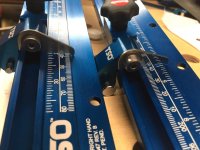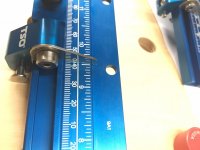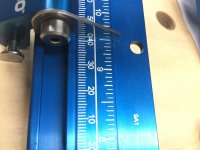MaximeLesveque
Member
- Joined
- Aug 13, 2021
- Messages
- 6
I purchased the TPG Parallel Guide System, and found that the system is well designed, but I have a hard time eyeballing the cursors.
I'm wondering if my eyes are to blame, or if there's a design flaw:
When trying to set cursors to the desired length, one of the following situation occurs:
+ the cursor is in the shade, and it makes it hard to see if it is directely before the desired line on the scale
+ the cursor is not in the shade, but because it is a shiny surface, light is reflected in my eyes, and the white lines on the scale become hard to distinguish from the shiny light blue surface.
Also, because the cursor is thicker than the lines on the scale, and happens to be above the lines, I suppose that one must calibrate (and use it) by placing the cursor directly before the desired line, while looking directly above.
The problem is that often when I place my eyes above, there is light shining right back in my eyes, and if I move sideways to avoid the reflection, I can then clearly see the difference between the white lines, and the light blue material of the scale, but I am no longer looking directly above, and the cursor will be off.
It seems that there would be easy fixes for this problem:
+ design cursor that is not above the lines of the ruler, but some kind of pointer that points from below the line
+ use a finish that doesn't reflect light so much for the ruler.
I have the 30" rulers, and I noticed that the rulers on the 50" rails are white tape with black lines. Perhaps the black on white, on a non shiny surface would solve the problem. If the tape happens to be less shiny that the anodized blue of the 30" rails.
Would like to know if some have had the same problem, and what solution they found. As it is, I'm thinking of replacing my 30" rails with the 50", because the 30" rails are a pain for the eyes. I'm hoping the seller will allow the exchange.
I'm wondering if my eyes are to blame, or if there's a design flaw:
When trying to set cursors to the desired length, one of the following situation occurs:
+ the cursor is in the shade, and it makes it hard to see if it is directely before the desired line on the scale
+ the cursor is not in the shade, but because it is a shiny surface, light is reflected in my eyes, and the white lines on the scale become hard to distinguish from the shiny light blue surface.
Also, because the cursor is thicker than the lines on the scale, and happens to be above the lines, I suppose that one must calibrate (and use it) by placing the cursor directly before the desired line, while looking directly above.
The problem is that often when I place my eyes above, there is light shining right back in my eyes, and if I move sideways to avoid the reflection, I can then clearly see the difference between the white lines, and the light blue material of the scale, but I am no longer looking directly above, and the cursor will be off.
It seems that there would be easy fixes for this problem:
+ design cursor that is not above the lines of the ruler, but some kind of pointer that points from below the line
+ use a finish that doesn't reflect light so much for the ruler.
I have the 30" rulers, and I noticed that the rulers on the 50" rails are white tape with black lines. Perhaps the black on white, on a non shiny surface would solve the problem. If the tape happens to be less shiny that the anodized blue of the 30" rails.
Would like to know if some have had the same problem, and what solution they found. As it is, I'm thinking of replacing my 30" rails with the 50", because the 30" rails are a pain for the eyes. I'm hoping the seller will allow the exchange.



